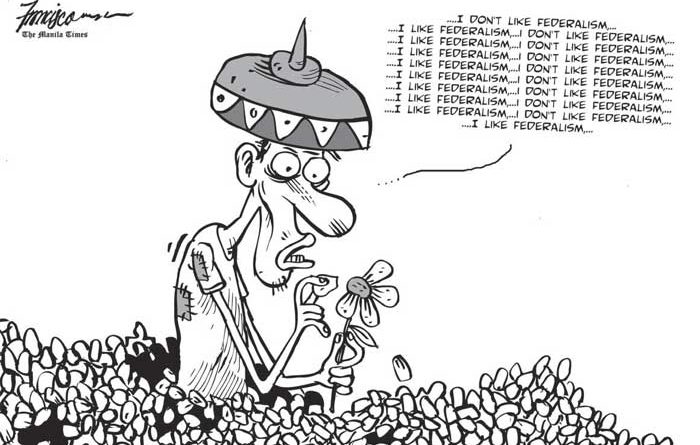OP ED EDITORIAL & CARTOONS: MANILA – FEDERALISM – Is there a vote for federalism?
Is there a vote for federalism?
.
.
Proponents of federalism face the daunting task of vending a Charter change (Cha-cha) seen by the masses as not a priority or beneficial to their future.
The shift to a federal system of government has been driven mostly by politicians with clashing motives and agenda—term extensions, power repositioning—as well as opposing modes of Cha-cha. Far from being inspired by public clamor, the new “federal-presidential” charter of the Puno consultative committee, which collides with the House version, was drafted by a small circle of lawyers, academics, politicians and ex-public officials, many from Mindanao. The group is a world apart from the 1986 Constitutional Commission, whose members came from various sectors and classes who risked their lives to topple the Marcos dictatorship.
What has been done to sell the new draft constitution? A few roadshow consultations have taken place, usually in hotels frequented by local politicians and local government units. The seeming exclusivity of these events basically shuts off the marginalized masses from critiquing a document that claims to echo their sovereign voice. In the drive for Cha-cha, a massive education campaign will be needed, given that over 65 percent of Filipinos oppose the move, according to surveys.
The champions of the “federal-presidential system” will have to explain some unsettling provisions. One says you can vote but cannot run for office in national and regional elective posts without a “college degree or its equivalent.” The provision brings the country back to the US colonial era where the right to vote and be elected was granted only to the landed and educated elite. Were elections held today under the new system, only about 9 million, or 15 percent, of voters can run.
The party-list system—a social justice tool in the 1987 Constitution—is out. In the new lower House of 400 members, 60 percent of the seats would be allocated to single-district representatives, while 40 percent is reserved for political parties under proportional representation. Of that 40 percent, one-half is allotted to marginal representatives for 12 years, after which they must compete with the more powerful traditional political parties.
The Puno committee also sees a self-executory antidynasty provision as the heart of the new system. But there is no assurance that it will pass in Congress when it convenes as a constituent assembly to enact the new charter. This will happen in light of the current bicameral committee’s decision to scrap the antidynasty provision of the Bangsamoro Organic Law.
Such hazy provisions make it doubtful whether the proposed charter will pass the test of scrutiny as an instrument of reform. Federalism has been defended as the antidote to the “unitary system” long monopolized by “Imperial Manila” and said to be the root of the country’s endemic woes. Accordingly, 18 federated regions with reserved and shared powers, including taxation and revenues and a big bureaucracy, are proposed under a “power distribution” scheme to reapportion some central powers to the regions.
But the Catch-22 here is that the new charter actually expands the presidential powers. For instance, the president handpicks all members of six new Constitutional Commissions, including the Federal Commission on Elections, the Federal Commission on Audit, and the Federal Ombudsman Commission. He also appoints at least three justices of the Federal Supreme Court, the Federal Constitutional Court, the Federal Administrative Court, the Federal Electoral Court, and other courts established by law.
To top it all, federated regions are ultimately subservient to the chief executive. The president can intervene using all measures in any region whose failure to comply with its constitutional obligations might supposedly threaten the federal republic. Further actions will be granted by Congress to the president until the “crisis” is resolved (Article X, Section 4). Presidential hegemony demands that the federated regions toe the line of the central government. The claimed “power distribution” favors, in fact, the central government.
Will such a charter be ratified by the people?
Bobby M. Tuazon is CenPEG’s policy studies direct
.
ASEANEWS EDITORIAL & CARTOONS:.
7.1. D. Tribune –Sorry she’s not <> Concept News Central –Way safer to walk the streets
7.2. Manila Bulletin – IMF cites need for balance between growth & stability
7.3. The Manila Standard –Reason for hope

7.4. The Manila Times – FEDERALISM
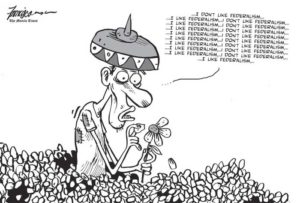
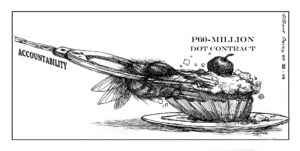
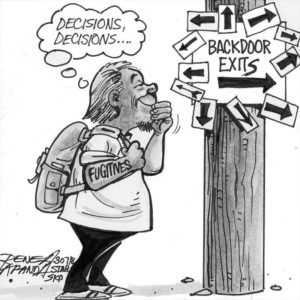
7. May ginagawa bang solusyon sa trapiko– Pilipino Star Ngayon – Aleng Maliit!

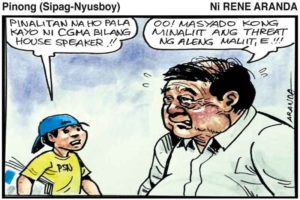
8.1. For The Straits Times – US-EU ties: When a kiss is just a kiss
Jonathan Eyal
Europe Correspondent
Jonathan Eyal was born in Romania, but has lived most of his life in Britain. Educated at Oxford and London universities, his initial training was in international law and relations, in which he obtained both his first degree and his Master’s with a Distinction. His doctorate, completed at Oxford in 1987, analysed relations between ethnic minorities in Eastern Europe. After teaching at Oxford for three years, Dr Eyal was appointed a researcher at the Royal United Services Institute for Defence Studies in London. Since 1990, Dr Eyal has been Director of Studies at the Institute. Dr Eyal has authored books on military relations in the Balkans and Eastern Europe, and became a regular commentator for The Guardian newspaper in London. He started writing for The Straits Times in 2001, and is currently the paper’s Europe Correspondent. He is fluent in French, Romanian, Italian, Hungarian and German.
 All photographs, news, editorials, opinions, information, data, others have been taken from the Internet ..aseanews.net | [email protected] |.For comments, Email to :D’Equalizer | [email protected] | Contributor
All photographs, news, editorials, opinions, information, data, others have been taken from the Internet ..aseanews.net | [email protected] |.For comments, Email to :D’Equalizer | [email protected] | Contributor

